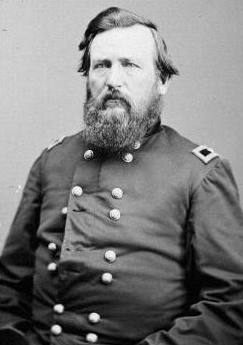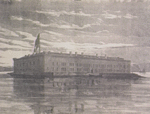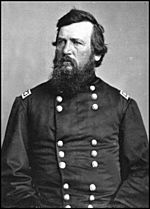Charles R. Woods facts for kids
Quick facts for kids
Charles Robert Woods
|
|
|---|---|

Brig. Gen. Charles Robert Woods
|
|
| Born | February 19, 1827 Newark, Ohio |
| Died | February 26, 1885 (aged 58) Newark, Ohio |
| Place of burial |
Cedar Hill Cemetery, Newark, Ohio
|
| Allegiance | United States of America Union |
| Service/ |
United States Army Union Army |
| Years of service | 1852–1874 |
| Rank | |
| Commands held | 76th Ohio Infantry 1st Bde., 1st Div., XV Corps 1st Division, XV Corps 2nd U.S. Infantry |
| Battles/wars | American Civil War |
Charles Robert Woods (born February 19, 1827 – died February 26, 1885) was an officer in the United States Army. He became a Union general during the American Civil War. He is known for leading the first attempt to resupply Fort Sumter before the war began. He served with honor throughout the conflict.
Early Life and Military Start
Charles Woods was born in Newark, Ohio. He grew up on his family's farm. He received some education through private lessons. His older brother, William Burnham Woods, and his brother-in-law, Willard Warner, also became Union generals.
In July 1848, Woods joined the United States Military Academy at West Point. He graduated four years later, ranking 20th in his class. After graduating, he became a second lieutenant. He joined the 1st U.S. Infantry Regiment. He later transferred to the 9th U.S. Infantry. Before the Civil War, he served in Texas and the Washington Territory.
Civil War Service
In early 1861, the U.S. Army ordered Woods to lead troops to Fort Sumter. This fort was in Charleston Harbor, South Carolina. On January 5, his group of 200 soldiers left New York Harbor. They sailed on a ship called the SS Star of the West. Another ship, the USS Brooklyn, went with them. Their goal was to bring supplies to Fort Sumter.
On January 9, Woods' ship entered Charleston Harbor. They were fired upon by an artillery battery from Morris Island. Woods later wrote about what happened:
We kept on, still under the fire of the battery, most of the balls passing over us, one just missing the machinery, another striking but a few feet from the rudder, while a ricochet shot struck us in the fore-chains, about two feet above the water line... The American flag Was flying at Fort Sumter, but we saw no flag at Fort Moultrie, and there were no guns fired from either of these fortifications. Finding it impossible to take my command to Fort Sumter, I was obliged most reluctantly to turn about, and try to make my way out of the harbor before my retreat should be cut off by vessels then in sight...
Woods and the Star of the West had to turn back. They returned to New York Harbor on January 12, 1861. This event showed the rising tensions before the war. On April 1, Woods was promoted to captain. On October 13, he became a colonel and took command of the 76th Ohio Infantry Regiment. His first assignment was in what is now West Virginia.
In 1862, Woods began serving in the Western Theater. This was the area of fighting west of the Appalachian Mountains. His regiment helped capture Fort Donelson in Tennessee on February 16, 1862. They also fought in the Battle of Shiloh on April 6. Woods was promoted to lead a brigade (a large group of soldiers). This was just before the Siege of Corinth in April. He then led his old regiment during the Battle of Chickasaw Bayou in December.
Woods fought well during the Vicksburg Campaign and the Siege of Vicksburg. For his actions at Vicksburg, he was given the honorary rank of lieutenant colonel in the Regular Army. This happened on July 4, 1863.
Woods also fought bravely at the Third Battle of Chattanooga in November 1863. For his efforts there, he received the honorary rank of colonel. On August 4, he was promoted to brigadier general in the Union Army. By January 1864, he was given command of a division (an even larger group of soldiers). He was made an honorary major general in the Union Army for his actions during the Battle of Griswoldville on November 22. This was the first battle of Sherman's March to the Sea. Woods received more honorary promotions in the Regular Army on March 13, 1865.
After the War
After the Civil War ended, Woods decided to stay in the U.S. Army. He commanded the Department of Alabama from June 1865 to May 1866. Then he commanded the Department of the South until August. He was promoted to lieutenant colonel in the Regular Army on July 28. He left the volunteer service on September 1.
Woods continued to serve in different infantry regiments. On February 18, 1874, he was promoted to colonel. He was given command of the 2nd U.S. Infantry. He held this position until he retired on December 15. He retired because his health was failing.
Woods passed away at his home in Newark, Ohio, at the age of 58. He was buried in Cedar Hill Cemetery in Newark. His brother and brother-in-law were also buried there.
Images for kids






